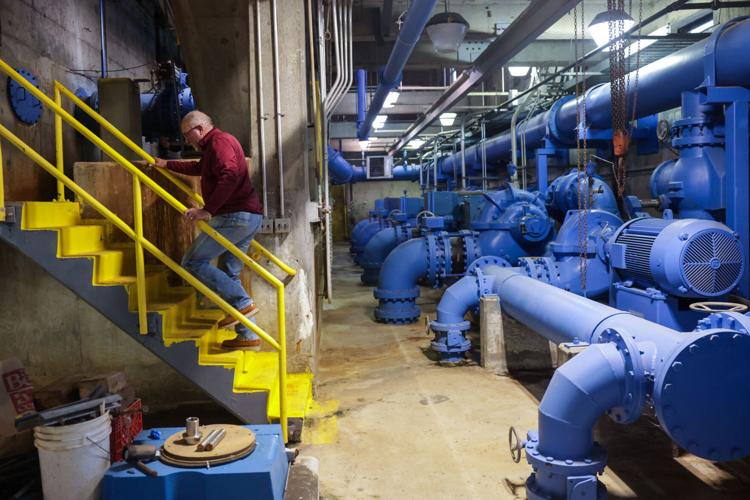MidAmerica Industrial Park is Paving the Way with Modernization and Industry Adaptation
04/05/2024

Multi-million dollar infrastructure investment prepares the park to meet the needs of existing and future industries of all sizes
In its commitment to modernization and preparing for the evolving needs of existing and future industries, MidAmerica Industrial Park has strategically allocated nearly $80 million in capital since 2015. This substantial capital injection is aimed at enhancing the Park’s infrastructure, ensuring it remains agile, competitive and capable of supporting the growth of advanced manufacturing companies of all sizes.
The six-member professional team at MidAmerica and board of trustees is steering the helm of this vast industrial landscape and is well aware of the complexities that come with preparing for a project of substantial proportions.
“We’re preparing for significant growth, and all the things that it takes to build a city need to be enhanced. It’s a very complex set of requirements to prepare for high-profile prospects seeking a site location,” Stewart remarked.
Spanning 9,000 acres in Mayes County, MidAmerica has channeled $60 million into critical water, sewer, electricity and road infrastructure improvements on approximately 2,000 acres earmarked for the forthcoming large project. This includes the construction of a 275,000-square-foot warehouse building tailored for potential companies, accompanied by a new terminal for its airport and an expansive runway. And nearly $20 million has been allocated for the expansion of its wastewater treatment plant, currently the third-largest in the state.
MidAmerica has dedicated over 1,200 acres for new housing initiatives, with a master plan in place for approximately 1,100 new homes. The park has invested $1.1 million in this endeavor, completing multi-family housing constructions and laying the groundwork for a regional community development plan focused on further infrastructure investments.
Roads and accessibility are another integral component of MidAmerica’s development strategy, with an investment of $18.9 million in new roadway construction. This includes expansions such as Zarrow Road, Armin Road and the upcoming Williams Street expansions, along with an additional half-million dollars dedicated to wayfinding construction and design.
Navigating through various opportunities, MidAmerica remains steadfast in its vision. The Park maintains an unbiased approach toward potential project suitors, recognizing the evolving market trends, particularly in the electric vehicle (EV) space. Stewart emphasizes, “The consumer will ultimately shape the market.”
Navigating through challenges, including high interest rates, low demand and technological shifts, Stewart sees a pause in the market as companies reassess their strategies.
“Now everybody is sorting out all of these issues and determining their strategy going forward. So all of these big companies are hesitating.”
MidAmerica, originally a munitions plant during World War II, has a rich history of reinvention, positioning itself as the eighth-largest industrial park globally and the third-largest in the United States. With more than 80 employers, the park supports the seven-county region where more than 4,500 workers live and raise families–MidAmerica generates over $732 million in wages and salaries annually. The labor shed market boasts more than one million people within a 45-mile radius and grows to more than 1.5 million in a 60-mile radius.
Home to five Fortune 500 companies, including the second-largest Google Data Center globally, this expansive workforce underscores MidAmerica’s vital role in the regional economy and its ability to draw from a diverse talent pool.
Looking ahead to 2024-2029, MidAmerica has ambitious plans for continued infrastructure enhancements. Water infrastructure investments include $4.7 million for water treatment plant upgrades, $3.6 million for wastewater treatment plant upgrades, $19 million for water distribution system upgrades, and $2.9 million for sanitary sewer collection system upgrades. Roads and accessibility remain a key focus, with a substantial investment of $24.5 million earmarked for new roadway construction. Additionally, a $7 million investment is planned for the design and construction of an airport runway extension.
These forward-looking infrastructure investments underscore MidAmerica’s commitment to creating a robust and dynamic environment, ensuring it remains at the forefront of attracting and accommodating large-scale projects. MidAmerica’s proactive approach involves accelerating the timeline to make the potential sites shovel-ready. Despite the uncertainty in the market, Stewart remains optimistic, pointing out that the necessary groundwork, including environmental studies, has been diligently undertaken.
As MidAmerica looks toward the future, Stewart and Sherry Alexander, Director of Business Development and Corporate Governance, envision growth. The strategic location, within 300 miles of 10 major metropolitan cities and next-day service capability to 23% of the U.S. population, positions the park for continued success.
Stewart concludes, “Like any business, an organization must continuously evolve, not only to remain relevant but also to surpass the competition. For the last 10 years, we have methodically positioned MidAmerica as an expansive site for a large employer.”
The journey continues for MidAmerica, a testament to its resilience, adaptability and unwavering commitment to shaping the future of industrial development.


